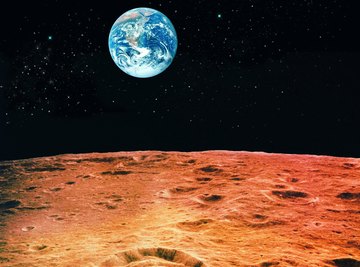
As Earth and the moon revolve around the sun, they periodically align with the sun in such a way that Earth moves into the moon's shadow and vice versa. Known as eclipses, these are spectacular events for observers on Earth. But they cannot occur on Mercury or Venus: Neither planet has a moon. Eclipses on the other planets in our solar system are possible but probably different than those on Earth.
Mercury
The first planet in the solar system, Mercury, is closer to the sun than Earth by more than half. From Mercury's surface, the sun appears three times as large as it does from Earth. If Mercury had a moon, it would have to be large enough to cover that disk for observers on the planet's surface to experience a solar eclipse. Such a moon, unless it were very close to the planet, would probably have to be larger than Mercury itself. Thirteen times every century, Earth falls into Mercury's shadow as it transits the sun and creates a tiny partial solar eclipse.
Venus
Venus, unlike Mercury, is closer to the Earth than it is to the sun and more closely resembles Earth in size and composition. There are no eclipses on Venus, but if a moon similar to the Earth's was placed at a similar distance as our moon, there probably would be. These eclipses might not be as spectacular as they are on Earth, however, because Venus is covered with a thick atmosphere.
Like Mercury, Venus periodically transits the face of the sun to create a tiny eclipse on Earth. These transits occur much less frequently than on Mercury, only twice every century. In the 21st century, these transits occurred on June 8, 2004, and June 6, 2012.
Mars
Mars is Earth's nearest neighbor that lies beyond Earth's orbit. It is smaller than Earth, but has two moons, Phobos and Deimos. These moons are very small, so small that they both lack the mass necessary for gravity to form them into spheres.
Phobos is very close to the Martian surface -- only 6000 kilometers (3728 miles) away -- and is often in the shadow of the planet. Deimos is a little less than one-tenth the distance from Earth to our moon. But Deimos is only 15 kilometers (9 miles) wide, so although it can easily disappear in the shadow of Mars, it can't produce an eclipse. Eclipses from Phobos are also only partial and because the moon moves so quickly, last no longer than 30 seconds.
Other Planets
The planets that lie beyond Mars are gas giants except for Pluto, which planetary scientists recently reclassified as a dwarf planet. All planets beyond Mars, including Pluto, have moons. Some of them, such as Jupiter's Ganymede, are larger than Earth's moon, and photos taken by NASA's Voyager and Cassini spacecraft reveal shadows of moons on the surfaces of Jupiter and Saturn. This indicates the occurrence of solar eclipses as these bodies transit the sun. Shadows of these planets are so large that the moons are in total eclipse for extended periods, up to eight days at a time in the case of Callisto, one of Jupiter's moons.
References
About the Author
Chris Deziel holds a Bachelor's degree in physics and a Master's degree in Humanities, He has taught science, math and English at the university level, both in his native Canada and in Japan. He began writing online in 2010, offering information in scientific, cultural and practical topics. His writing covers science, math and home improvement and design, as well as religion and the oriental healing arts.
Photo Credits
Digital Vision./Digital Vision/Getty Images
